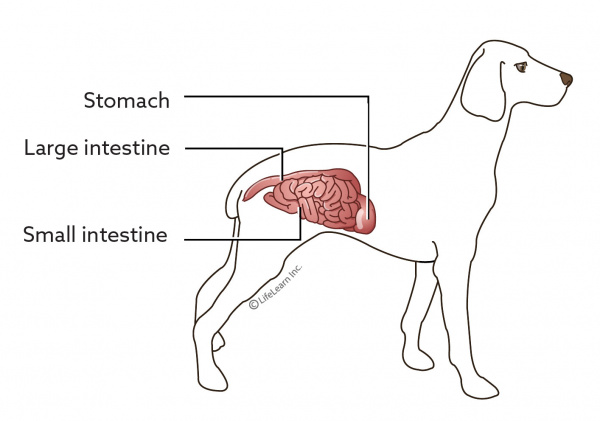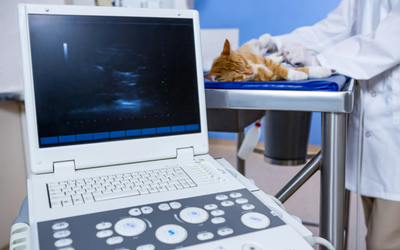How Do You Know if Your Dog Has Stomach Cancer
What is a tumor of the breadbasket? 
A tumor of the stomach is an abnormal proliferation and dysregulated replication of the cells that make upwards the stomach. Stomach tumors normally grow from the cells of the inner lining of the stomach or muscle that surrounds the lining.
Stomach tumors may be either benign (non-cancerous) or malignant (cancerous). Malignant tumors are invasive and decumbent to metastasize (spread to other areas of the trunk). Well-nigh tumors of the breadbasket are malignant.
Gastric (breadbasket) tumors are uncommon in dogs and cats. Leiomyosarcoma is the most common cancer in dogs, and lymphoma the well-nigh common cancer in cats. Other gastric tumors in dogs include lymphoma, the smoothen muscle tumors (leiomyomas and leiomyosarcomas), adenocarcinomas, mast cell tumors, fibrosarcomas, plasmacytomas, and gastrointestinal stromal tumors (GISTs), amid others. Rarely, dogs can have benign adenomatous polyps.
"Gastric (stomach) tumors are uncommon in dogs and cats. Gastric (stomach) tumors are uncommon in dogs and cats."
In cats, the next most common tumors include leiomyosarcomas, adenocarcinomas, mast cell tumors, plasmacytomas, carcinoids, GISTS, and others. Cats tin can also, simply less ordinarily, develop benign tumors, including adenomatous polyps, adenomas, and leiomyomas.
What causes this cancer?
The reason why a particular pet may develop this, or any other tumor or cancer, is non straightforward. Very few tumors and cancers have a unmarried known cause. Virtually seem to be caused by a complex mix of risk factors, some environmental and some genetic or hereditary. In the case of stomach tumors, age, sex, and brood announced to be chance factors.
Stomach tumors tend to develop in older dogs and cats. Males are generally at higher take chances than females, both for benign and cancerous tumors. Certain breeds are at an increased risk, including Beagles for leiomyoma, and Chow Chows, Crude Collies, Staffordshire Terriers, Belgian Shepherds, Norwegian Lundehunds, and Dutch Tervueren Shepherds for adenocarcinoma. This may point a genetic predisposition. Siamese cats also appear to exist predisposed to adenocarcinoma.
In dogs, gastric adenocarcinoma has been linked to the long term feeding of nitrosamines (a blazon of chemical plant in many foods) in the diet.
What are the signs of stomach tumors?
The signs of breadbasket tumors develop gradually over weeks to months. They include chronic intermittent airsickness, lack of appetite, languor, and weight loss. Vomit may be blood-tinged or have a "java grounds" appearance. This is related to tumor ulceration (opening) causing bleeding. The bleeding may crusade the stool may go blackish. Chronic haemorrhage can pb to anemia (depression circulating cerise claret cells) causing paleness of the gums. Sometimes excessive salivation may be seen, a symptom of nausea.
Pets with gastric leiomyomas or leiomyosarcomas (muscle tumors) can develop a lower than normal claret glucose (hypoglycemia). This is a type of paraneoplastic syndrome, a condition when substances released past cancer cells touch on the operation of other organs. Signs of depression blood glucose (blood sugar) include restlessness, weakness, trembling, disorientation, and seizures. Another paraneoplastic syndrome with leiomyomas and leiomyosarcomas is tumor-associated nephrogenic diabetes insipidus. This status causes excessive drinking and urination.
Cats and dogs with adenomatous polyps often have no symptoms of cancer.
How is this cancer diagnosed?
Your veterinary may suspect stomach cancer in older dogs or cats with a history of chronic airsickness, lack of appetite, and weight loss. The findings with a physical examination are variable. If your pet's stomach is markedly enlarged, your veterinarian may be able to palpate (experience) a gastric mass or gastric thickening (sometimes painful). Intestinal palpation may also reveal enlarged lymph nodes.
"Bloodwork and urinalysis are helpful to detect the changes associated with the paraneoplastic syndromes."
Your veterinarian volition perform tests such as blood tests, urinalysis, imaging, endoscopy, or surgery and a biopsy. Bloodwork and urinalysis are helpful to detect the changes associated with the paraneoplastic syndromes. Radiographs (X-rays) may show a thickened gastric wall or displacement of the stomach, and specialized imaging (a barium swallow) may show ulceration in the tummy, reduced stomach movement, or gastric obstruction. 
Ultrasound is besides helpful, particularly to examine the layers of the stomach wall and to obtain an ultrasound-guided fine needle or cadre needle biopsy. This procedure involves taking a modest needle with a syringe and suctioning a sample of cells directly from the tumor and placing them on a slide. A veterinary pathologist then examines the slide under a microscope.
Endoscopy, a procedure that uses an endoscope (i.e., a thin tube with a calorie-free and tiny camera at the terminate, and through which forceps can exist passed to take tissue samples) can be useful to diagnose the presence of a tumour and collect biopsy samples. As with needle biopsies, these samples are not always valuable for diagnosis and instead a surgical biopsy may be needed to obtain a definitive (accurate) diagnosis. Surgical biopsies may be collected via laparoscopy, a process using a laparoscope (a thin, tube-like instrument with a low-cal and lens), or laparotomy (a surgery to open up the abdomen). To identify the type of cancer, the biopsies are examined by a veterinary pathologist nether the microscope. This is called histopathology. Histopathology is not only helpful to make a diagnosis but can indicate how the tumor is likely to behave.
How does this cancer typically progress?
How cancer of the stomach progresses depends on the blazon of tumor and how it affects the torso. Some tumors grow very slowly while others grow quite fast. Without treatment, both beneficial and malignant tumors will continue to grow, increasingly interfering with tummy functioning and risking ulceration or gastric obstruction. In some cases ulcerative tumors tin can atomic number 82 to perforation of the tummy, with the spillage of stomach contents into the belly leading to a life-threatening infection (septic peritonitis).
Every bit near stomach tumors are cancerous, most metastasize to other areas of the trunk, including the nearby lymph nodes, liver, and lungs, too as other organs and the inner lining of the abdomen. With the hazard of metastasis, staging (searching for potential spread to other locations in the torso) is highly recommended. This may include bloodwork, urinalysis, Ten-rays of the lungs, and possibly an intestinal ultrasound. Occasionally more avant-garde imaging is used, such as computed tomography (CT) scans or magnetic resonance imaging (MRI). If whatsoever lymph nodes are enlarged or experience abnormal, further sampling may exist pursued to decide if spread is nowadays. Staging 'sets the stage' for the near appropriate plan of care.
What are the treatments for this type of tumor?
The treatments for stomach tumors depend on the type of tumor and extent to which it has grown and spread. With most stomach tumors, surgery is the treatment of pick.
"The treatments for tummy tumors depend on the type of tumor and extent to which it has grown and spread."
The surgical removal of tumors that take metastasized is primarily palliative, to ease symptoms and improve quality of life. The long-term outlook in these situations tends to exist limited, with surgery providing a few months of relief before the metastatic growths become problematic or the tumor regrows. In some cases, surgery tin be followed with chemotherapy.
Gastric lymphoma in dogs and cats can be localized (growing every bit a mass in one location) or lengthened (spread out as a general thickening of the stomach wall). Surgery is advised if it is possible, every bit information technology volition help convalesce the signs of the cancer, but typically lymphoma is treated with chemotherapy whether or not the tumor is removed. Sometimes chemotherapy is the preferred handling approach with gastric lymphoma in dogs and cats. In some cases, radiations therapy may besides be recommended.
In the example of musculus tumors, when the tumor is removed, the signs of the paraneoplastic syndrome will resolve. After surgery, smaller, more frequent meals may be necessary.
Is there annihilation else I should know?
The outlook can vary from splendid to poor, depending on the type of tumor, whether it has spread to other areas of the torso, the number of tumors present, and whether all the cancer tin be removed. Sometimes the prognosis is express by the degree of debilitation (eastward.m., weight loss, and malnourishment) or other wellness weather your pet has. Your veterinarian or veterinary oncologist will be able to provide guidance on the best programme of care for your pet.
Source: https://vcahospitals.com/know-your-pet/stomach-tumors-epithelial
0 Response to "How Do You Know if Your Dog Has Stomach Cancer"
Post a Comment